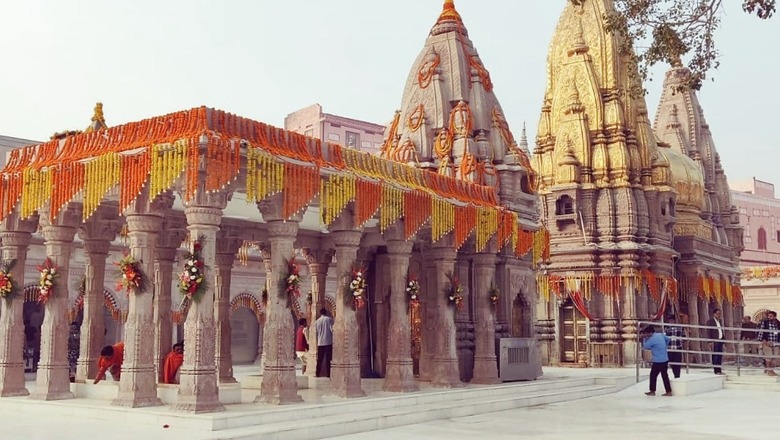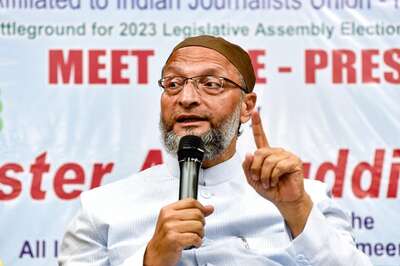
views
Kashi, Varanasi or Benares is one of the oldest continuously existing cities (possibly even the oldest) in the world. In Kashi, every lane and every turn is part of history. Every building that has been broken down, restored or left to ruin is part of history. People have come to the city in search of so many things; wealth, victory or moksha, and for centuries. Most have been forgotten completely. The very lucky ones survive in local tales and oral histories. Even fewer make it to history that is written down. Only the most fortunate get to leave an actual mark upon the city, to build history upon history.
In its current form, Kashi is being reinvented, with a majestic corridor and gateway around Vishwanath Temple, looking over the waters of the ever-flowing Ganga river. Prime Minister Narendra Modi will inaugurate it today. But what is the need to reinvent this city? For this, let us ask ourselves something much more ambitious.
What is the essence of Hinduism? Only the most enlightened could possibly have an answer to this question. But in the inherently democratic spirit of Hindu society, everyone can try. And it is always best to keep things simple. To me, Hinduism is a bunch of traditions passed down from one generation to the next.
These traditions evolve constantly, because they are living. But they have two central features. First, they are bound to the Indian subcontinent. The geography of Bharat, its rivers and forests, the seasons and even the trees and crops that grow here play an essential role within these traditions. In that sense, the Hindu religion is not portable, unlike Christianity for instance. What significance would the Ganga, Narmada or Kaveri river have for someone living in California?
The second thing is that these traditions are common threads that run through every social and linguistic group that makes up our overwhelmingly diverse nation. The concept of “abhishek”, for instance, would be translatable into every Indian language, yet impossible to explain in English. You have to belong to the tradition to understand what it means. This makes India more than just a collection of people groups, and our country more than a sum of pieces of land.
Without these traditions, there are no Hindus and there is no India. The primary task, therefore, is to make sure that these traditions are passed on. For that, Hindus need a majestic spiritual capital (or capitals) that focuses attention on the power of the Indian civilization. It should attract the people to their ancient faith system and inspire them to stick to it. Otherwise, in the competitive market of religion, Hindus will lose out.
A congested old city cannot serve this purpose. When Hindu parents bring a child to Varanasi, the child’s first impression should be one of grandeur. It should stir their natural curiosity. It should make them wish to learn more about the stories and the histories of Kashi, the kings and the artisans who built the city, and in a larger sense about the legacy of Hindu civilization. They should wonder about the generations of Hindus who came to the spot and why they were there. Walking in, they should feel proud of what they have inherited. They should wish to advance it.
First impressions matter. Was the old Kashi, or the current state of most of our Hindu holy sites for that matter, accomplishing this? Let us ask ourselves this question honestly.
But wait, you might say. Can’t we look beyond the apparent chaos and see what is deep within? Isn’t that the whole point of India? It requires a bit of plain speaking, but the answer is no. Not in the competitive market, at any rate. If we make our offerings hard to find, people will just move on to the next one. There are always Abrahamic religions, and Communism. Or wokeness.
If you observe what is common to the latter, it is ease of entry. Even Communism, which had been almost thwarted by the end of the twentieth century, is back in new ways more palatable to young people. On the other hand, Bharat has been getting smaller, both internally and externally, even in the last one hundred years. If we demand significant mental effort to look past the dirt and chaos to appreciate what is inside, there will be fewer and fewer of us. If we keep raising the entry barriers, the chipping away at Bharat is likely to continue.
So should we be so concerned with what is on the outside? Yes, because that is what attracts attention. It gets people in the door.
Curiously enough, the Kashi Vishwanath corridor project has been criticized not only by liberals, but also a section of conservatives. The liberal criticism is on predictable lines. What good are temples? Why not a school or hospital? It would be helpful if such noble sentiments were equally applied to the current controversy over the use of public space in Gurugram. Until then, I apologize for seeing through the trick.
The conservative criticism is more interesting, but impractical. Every site in the city is a living god. Why disturb Kashi? Because getting people in the door is the most important. Only once you have enough people inside, you will find the small fraction that will transcend to higher levels of consciousness.
The diffused, introverted nature of Hinduism has long been a significant advantage for those looking to chip away at Bharat. Just like ancient Bharat was a loosely defined region with many political systems. This was used most often by detractors to argue that India never existed at all. And therefore it does not matter how many pieces it is broken into. Bharat ke tukde and all that. To put a stop to such mischief, we have modern India, which is a nation state with hard borders, a Constitution and a central government. Of course, India is more than that. The idea of one Bharat Mata automatically invalidates all demands for Bharat ke tukde. It would be great if everyone understood that, but they don’t. Which is where the hard borders help.
The same goes with Hinduism. To stop the chipping away, if we have to adopt some of the trappings of an organized religion, so be it. Hindus deserve something that looks at least as good as the Vatican, and advertises our soft power. The wealth creation that comes from tourism is a plus.
And, so we approach the ancient city of Kashi, with both humility and pride. We build the best new Kashi we can. Future generations will see this. Perhaps someone else, a thousand years hence, will build upon it again. It will reflect the needs of their age, and the glory of Hindu civilization at that time. We look forward to living on in the stories they tell.
Abhishek Banerjee is a mathematician, columnist and author. The views expressed in this article are those of the author and do not represent the stand of this publication.
Read all the Latest Opinions here















Comments
0 comment